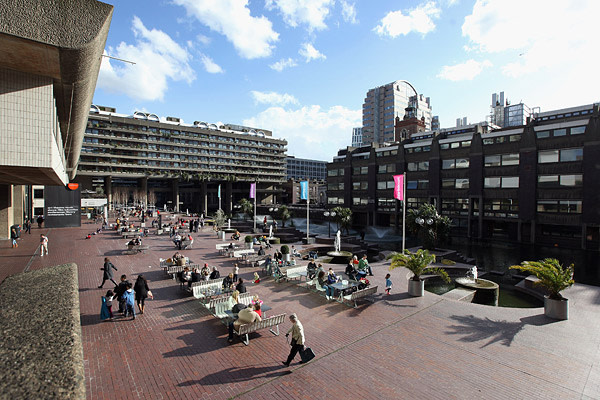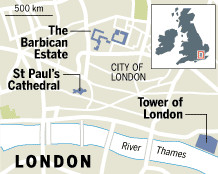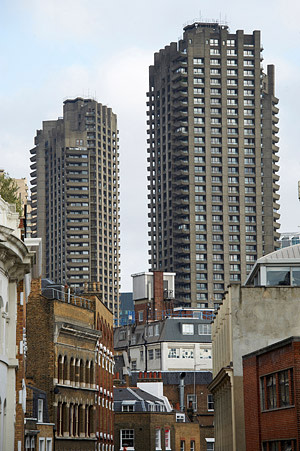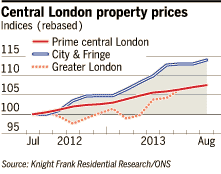London’s Barbican: village life on a City estate

Simply sign up to the Life & Arts myFT Digest -- delivered directly to your inbox.
Jane Smith believes she lives in a village – albeit a concrete fortress of a village inside the City of London, with paved terraces and hard-edged water features standing in for the village green and the duck pond.
Not everyone shares her admiration for the Barbican Estate, which has regularly featured in lists of London’s ugliest buildings. Nevertheless this seminal example of brutalist design has quietly established itself as a thriving section of prime central London.
Average property prices have risen above £1,000 per sq ft, and the arrival of Crossrail in 2018 should provide a further fillip, giving residents a direct line from nearby Farringdon to the West End and Heathrow airport.
“It is a really good place to live,” says Smith, who chairs the Barbican Association. “I think it is visually stunning; it is robustly built, which means there is not much neighbour noise, and it is very central so you can get everywhere quickly. One thing that is surprising is how many families with children live here, and that gives it a real sense of community with people of all ages.”

Like any good village, the Barbican has social groups: the Tuesday Club for retirees, and the horticulture society runs window-box competitions. It even has an answer to the farm shop, with Geranium offering artisanal foods and organic fruit and vegetables.
The Barbican Estate was built on a 40-acre former bomb site half a mile northeast of St Paul’s Cathedral. It was designed in 1959 by Chamberlin, Powell & Bon to provide practical homes for single City professionals. Its flats were designed with floor-to-ceiling windows to maximise light and space, but kitchens and bathrooms were small and functional. Each flat has sliding windows with access to a private balcony.
The project cost £156m and took more than 20 years to complete, with much of the residential space being built between 1969 and 1980. In 1982 it was officially opened by the Queen, who declared it “one of the wonders of the modern world”.
But the Barbican has divided public opinion ever since. It was given Grade II-listed status in 2001, but two years later beat Centre Point and the MI6 building to top a poll of London’s ugliest buildings. Today its mid-century-style interiors (including timber suspended staircases and bespoke bathroom sinks) – protected by that listed status – are right on-trend.

Smith struggles to name any downsides to living at the Barbican – other than being surrounded by construction work. Work on boring the Crossrail tunnel beneath the estate will begin next year and some residents are naturally nervous about the possibility of structural damage. “Buildings are constantly being built and rebuilt in the City,” says Smith. “You do have to get used to some construction noise, and inevitably the new buildings are taller than the old ones and that means you can feel a bit walled in.”
Among these lofty new neighbours is The Heron, a 36-storey residential tower where off-plan selling prices start at £1,200 per sq ft. By comparison, Tina Evans, group director of estate agents Frank Harris, estimates that the Barbican sells at £1,000 to £1,200 per sq ft, an increase of 15 to 20 per cent in the past 18 months.
This means that prices for studio flats start from about £350,000, with one-bedroom properties selling from about £475,000 to £850,000. Chesterton Humberts is currently selling a one-bedroom duplex on Frobisher Crescent, featuring a remote-controlled wall that separates the sleeping and living spaces, for £725,000.
Two-bedroom homes sell for £800,000 to £900,000, with top-end homes easily breaching the £1m mark, Evans says. A three/four-bedroom apartment on the 25th floor of Cromwell Tower is on the market for £1.6m with Hamilton Brooks. Meanwhile, Frank Harris is selling a recently refurbished four-bedroom townhouse for £2.25m.

Evans attributes recent price rises partly to shortage of stock, and partly to buyers seeing the City as a residential option – thanks to the recent opening of the high-end One New Change shopping centre, and the bars and restaurants at Smithfield.
Glen Cook of Hamilton Brooks says his Barbican buyers are often UK downsizers looking for a safe central home, rather than overseas investors. Evans says her clients tend to be City bankers and lawyers – but adds: “A lot more families are moving in now. And obviously, given the prices, it is a more mature crowd.”
Nearby, regeneration is under way, with Goldman Sachs building a new headquarters on Farringdon Street and Amazon moving to Holborn Viaduct. Helical Bar has planning permission for a mixed redevelopment (flats, offices, shops and restaurants) on a part of the St Bartholomew’s Hospital site, and there are also plans to redevelop Smithfield Market.
Of course, a brutalist village is not to everyone’s taste. “Sometimes I get buyers who say: ‘Absolutely not; it’s so ugly,’” says Evans. “On a dark and rainy day it’s not particularly pretty but on a sunny day you can sit on the lakeside and it’s lovely.”
——————————————-
Buying guide
● There are roughly 2,000 flats at the Barbican, making the estate home to some 4,000 people.
● The top-performing City of London School for Girls is the only secondary school within the Barbican. The City of London School for Boys is 10 minutes’ walk away near St Paul’s.
● Annual service charges range from about £1,600 for studio flats, up to £15,000 for the largest penthouses.
● City of London police say a total of 915 crimes were committed in the borough in July and August this year. Because the City’s daytime population is inflated by commuters to an estimated 308,000, the 2013 crime rate comes to 2.97 per 1,000.
What you can buy for …
£500,000 A one-bedroom flat with about 400 sq ft of living space.
£1m A spacious three-bedroom flat (around 1,100 sq ft) in one of the Barbican towers
£2.5m A four-bedroom townhouse with integral garage and roof terrace.
Comments